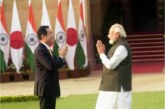[The situation in Afghanistan is very fragile under the prevailing circumstances. NATO has been militarily active on Afghan soil for the past one decade and it is likely to stay in the region in the near future as well on the pretext of containing Taliban. And it is a long-term strategy to expand NATO’s sphere of influence in Central and South Asia to secure American and Western interests.]
The US-led war in Afghanistan has entered its tenth year on 7 October 2010 and this conflict represents the longest continuous combat operations in the history of the United States and Afghanistan alike. The North Atlantic Treaty Organization (NATO) entered the fray in September by activating its Article 5 mutual military assistance clause.
There are 150,000 foreign troops in Afghanistan, 120,000 of them under the command of NATO’s International Security Assistance Force (ISAF), drawing military personnel from over a quarter of the 192 members of the United Nations and include soldiers from almost every European country, several Asia-Pacific states, and nations in the Americas and the Middle East.
NATO has grown from 19 to 28 members since it took control of ISAF in 2003 and has expanded military partnerships with several nations that have deployed troops to Afghanistan, from Australia to Georgia, Montenegro to South Korea, and Armenia to the United Arab Emirates.
Troops from at least 26 nations serving under NATO’s ISAF have been killed in Afghanistan, a record number of countries to sacrifice soldiers in one nation. 521 foreign troops lost their lives in the Afghan war theater last year, a dramatic increase from the preceding year when 295 were killed. So far this year the number is 478, with 2010 poised to be the deadliest year in the nine-year war for U.S. and NATO forces.
On 21 August this year, as many as 1,000 Afghans demonstrated in the streets in Baghlan province after NATO raided a house in the Baghlan-i-Jadid district, killing one civilian and abducting two others. “Chanting anti-government and anti-NATO slogans, the protesters warned [they would] hold demonstrations in the future if the killing of civilians is not investigated.”1
NATO’s claim that the International Security Assistance Force was a peacekeeping and reconstruction initiative is no more given credence by international public opinion. In early September this year, the German Bundeswehr announced that it was dropping all charges against Colonel Georg Klein, who ordered a NATO air strike in Kunduz province in September 2009 that killed 142 people, by Afghan accounts all civilians.2 “Investigators found no evidence that Klein had broken any rules.”3
On 29 August this year, German Defense Minister Karl-Theodor zu Guttenberg paid an unannounced visit to “a combat zone in Afghanistan” – in Kunduz province – “the first time a senior German politician has met German troops who are facing off day to day against the Taliban.”4 15 kilometers from the rapid reaction force base he inspected, four German soldiers were killed in a firefight this April. Guttenberg participated in “ceremonies paying tribute to German soldiers who had been killed.”5
The Afghan war is also providing the 12 Eastern European countries brought into NATO in the past 11 years as well as new partners in the Asia-Pacific region their first combat in decades. Along with operations in Iraq starting in 2003, new NATO members are involved in warfighting for the first time since War World II and NATO Contact Countries like Australia, New Zealand and South Korea for the first time since the Vietnam War.
Despite talk of a drawdown of NATO military forces in Afghanistan, new member states in Eastern Europe are being tasked to increase the deployment of troops and ordnance to the war front. NATO’s war in Afghanistan is being used not only to integrate the armed forces of over 50 nations into a U.S.-controlled globally deployable military force, but also to expand the Pentagon’s reach into Eastern Europe, the South Caucasus and Central Asia, ever closer to the borders of Russia, Iran and China.
Since 2005 the U.S. has acquired seven new military bases in Romania and Bulgaria, including strategic air bases, and launched the world’s first multinational strategic airlift operation at the Papa Air Base in Hungary. In June the U.S. led 100 personnel from five NATO nations in the first paratroop exercise under the auspices of the Heavy Airlift Wing at the Hungarian base. An American sergeant present at the drills said, “It’s…beneficial for the other countries participating if they were to deploy to Afghanistan, because from the training, they would understand how the U.S. military works.”6
NATO Training Mission – Afghanistan announced on 28 August this year that Lithuania would deploy military personnel to train the Afghan National Army, partnering with Ukraine, not an official ISAF troop contributor. The former Soviet states signed a two-year commitment to begin in 2011. This demonstrates that NATO has no plans to leave South Asia in the imminent future.
A report entitled “Romania shows its support for the U.S.-led mission in Afghanistan” published in Los Angeles Times on 19 August 2010 stated “the U.S. military and political leadership has put a priority on strengthening ties with Romania,” which has turned four military bases over to the Pentagon and NATO in recent years and this February announced it would host American land-based Standard Missile-3 anti-ballistic missiles.
While the Netherlands became the first NATO member state to withdraw troops from Afghanistan, since 2009 Romania has increased its contributions to NATO’s Afghan war effort from 962 to over 1,500 troops, “even as Romania’s economy is suffering and defense spending is being cut. To the Romanians, participation in the Afghan mission is a good way to demonstrate their bona fides as a member of the North Atlantic Treaty Organization and as an ally of the United States….”7
In August this year Bulgaria sent 200 army rangers to Afghanistan in the same week. At the beginning of August Defense Minister Anyu Angelov “announced that Bulgaria was going to change the functions of the Bulgarian troops in Afghanistan, and that instead of guard units, it was going to send a 700-strong combat regiment by the end of 2012.”8
Montenegro, the world’s youngest nation (and newest member of the United Nations) with a population of only 670,000, lately deployed its second contingent of troops to Afghanistan. The diminutive Adriatic state became independent in 2006 and joined NATO’s Partnership for Peace program the same year. In 2007 NATO signed a pact with Montenegro permitting the bloc’s troops to cross the country, and in 2008 granted it an advanced Individual Partnership Action Plan. In 2009, NATO followed up with a Membership Action Plan, the final step to full membership.
This year Montenegro became the 44th Troop Contributing Nation for NATO’s Afghan mission, preceded by Armenia – the first member of the Russian-led Collective Security Treaty Organization to be assigned that role – and followed by Mongolia, South Korea and Malaysia, to indicate NATO’s expanded reach into Asia.
On 24 August 2010 Australia – a NATO Contact Country partner along with Japan, New Zealand and South Korea – lost its 41st soldier in Afghanistan. With 1,550 troops in the country, Australia is the largest non-NATO contributor.
NATO’s role in Asia is not limited to 120,000 troops in Afghanistan, Kyrgyzstan, Tajikistan and Uzbekistan. It is steadily deepening military partnerships with an expanding array of Asia-Pacific nations.It is also consolidating its grip on the three former Soviet republics in the South Caucasus: Armenia, Azerbaijan and Georgia, all of which have troops serving under the Alliance in Afghanistan. The war in Afghanistan provides long-range integrated combat training for global NATO and a foundation for the U.S. to build a far-reaching military network unprecedented in scope.
AT its recent meeting in Lisbon, the U.S.-led coalition in Afghanistan formally adopted a transition plan on 18 November this year designed to turn over control of the war to Afghan security forces by 2014 but continue heavy financial and military support for the indefinite future. NATO Secretary-General Anders Fogh Rasmussen while addressing a press conference the same day said: “Here in Lisbon, we have launched the process by which the Afghan people will once again become masters in their own house.”9
After NATO and the 20 other nations in the coalition sealed agreement on the 2014 transition goal, Karzai and Rasmussen signed an accord instituting what was called the NATO-Afghanistan Partnership, essentially a guarantee that as foreign forces wind down their combat role over the next four years they will not abandon Karzai’s government in its struggle against Taliban insurgents.
The turnover is expected to begin as early as this spring, at least symbolically, and gradually spread across the country as Afghan security forces strengthen to about 300,000 and, with intensified coalition training, improve their ability to confront Taliban rebels without foreign help, NATO officials said.10
These developments indicate that NATO is unlikely to leave Afghanistan in the immediate near future because it provides NATO an opportunity to expand its sphere of influence in Central and South Asia as well as other strategic adjacent regions.
NOTES
- Xinhua News Agency, August 21, 2010.
- Following Afghan Election, NATO Intensifies Deployment, Carnage, Stop NATO, 6 September 2010, see http://rickrozoff.wordpress.com/2009/09/06/following-afghan-election-nato-intensifies-deployments-carnage .
- Deutsche Welle, 19 August 2010.
- Deutsche Press-Agentur, 29 August 2010.
- Ibid.
- US, Air Forces in Europe, 17 June 2010.
- Los Angeles Times, 19 August 2010.
- Sofia News Agency, 18 August 2010.
- Edward Cody and Karen DeYoung, “NATO adopts transition plan for Afghan war”, Washington Post, 20 November 2010, at http://www.washingtonpost.com/wp-dyn/content/article/2010/11/20/AR2010112001164.htm?
- Ibid.
Source: Third Concept/December 2010/Vol.24/No. 286/P.no. 7/


